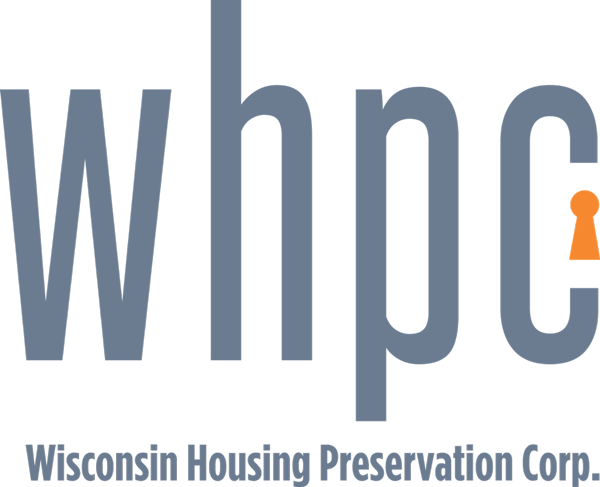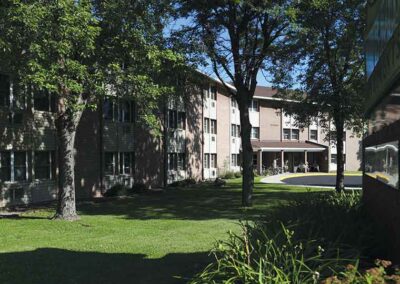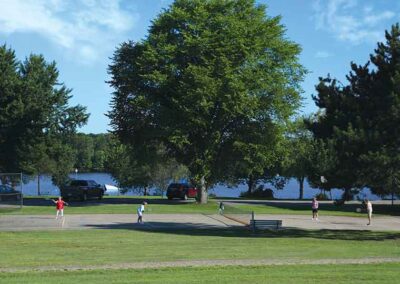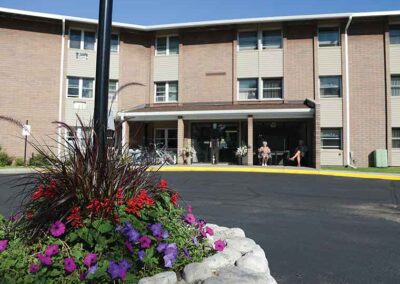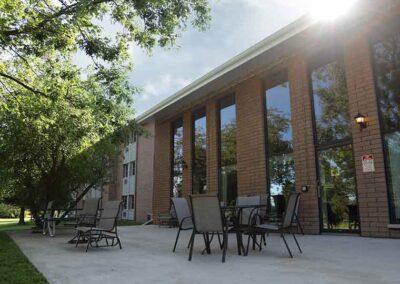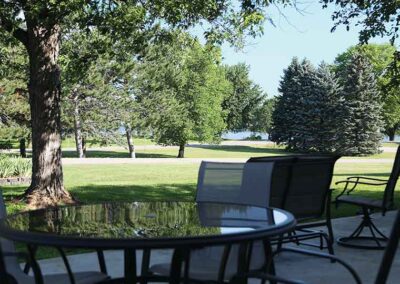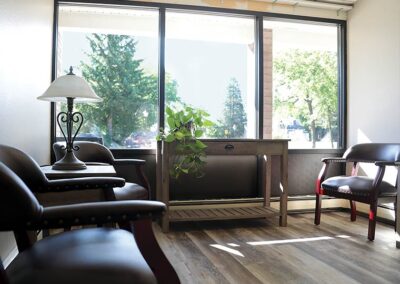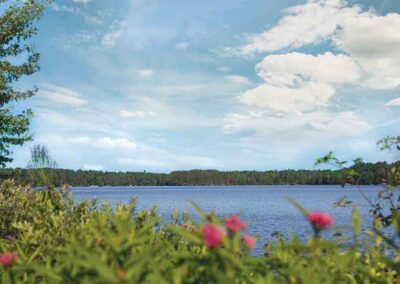Rhinehaus Apartments Case Study
Rhinelander, WI • Oneida County
About the Project
Rhinehaus is a 65-unit independent-living senior housing complex located in the northern Wisconsin city of Rhinelander. It is situated on a scenic lot across from Hodag Park along shores of the Wisconsin River. Rhinehaus has been fully occupied for many years due in large part to its desirable location—just blocks from downtown with access to essential services including doctors, pharmacies, and grocery stores.
Highland Estates I and II, a family housing complex, and Rhinehaus, a senior-living facility, were originally acquired by WHPC in 1999. The properties were the fourth and fifth acquisitions by WHPC, known then as Wisconsin Housing Preservation Trust.
Both properties were originally built and financed in 1979 through a Housing and Urban Development (HUD) affordable housing subsidy program. An appraisal at the time of sale to WHPC determined the properties were in good condition.
The Process
WHPC purchased both properties from the same owner at the same time. To preserve their Section 8 statuses, the acquisition was divided into two government subsidized HAP (Housing Assistance Payments) contracts, with Highland Estates I and Rhinehaus comprising one contract, and Highland Estates II, the other contract. WHPC combined them into one portfolio after the sale.
Since the purchase in 1999, WHPC invested about $1.8 million in ongoing maintenance and updates at Rhinehaus. Those funds enabled WHPC to perform necessary maintenance and modest one-off incremental renovations to manage the existing physical condition of the property, which was already 20 years old at the time of acquisition. To revitalize the assets and help stabilize the neighborhoods, it became clear a substantial investment in a complete rehab was needed.
In 2019, WHPC applied for and was awarded a federal nine percent tax credit subsidy by the Wisconsin Housing and Economic Development Authority (WHEDA) for a substantial rehab of the property with its own scope of work. Nine percent tax credit awards are highly competitive and WHPC was fortunate to have been one of just a few developers awarded tax credits that year.
The Challenge
Due to the volume of rehab construction proposed, it was critical to accurately determine construction cost estimates and demonstrate the relevance of the proposed expenditures on the Capital and Needs Assessment portion of the tax credit application. All costs and deadlines are firm. Developers cannot spend more than the costs identified in the scope of work described in the tax credit application and must complete construction within the timeframe proposed.
To complete the tax-credit contract, WHPC entered an ownership structure with the majority investor, Boston Capital. WHPC maintained a small position as the managing stakeholder, which oversees daily operations and housing quality through its property management partner, Meridian Management, Inc. For the next 15 years of the tax credit relationship most returns on investment go to Boston Capital.
Although the exterior was structurally sound, WHPC did funnel nearly $2 million over the next 20 years into various interior rehab updates and general maintenance to keep the units and common areas in good condition. However, Rhinehaus was ready for a more complete facelift of the building, apartments, and grounds after years of performing ongoing repairs.
Our Solution
When the newly awarded tax-credit subsidized rehab work began in 2019, most of the renovations focused on the interior of the building. Because the rehab was completed before the onset of the COVID-19 pandemic, contractors were able to remodel the units with tenants in place. Every unit received new kitchen appliances, bathroom vanities, and closet doors. Window air conditioners were replaced in all units.
In the common areas new flooring was installed and the elevator was upgraded. An intercom system and outdoor security surveillance system was installed, and WIFI was provided throughout the building. The entry foyer was redecorated with comfortable seating and side tables with task lighting. And a new office space was added near the front entrance for the property manager.
The community room was updated with luxury plank vinyl flooring, modern lighting fixtures and new furnishings. The space includes an area with a computer, printer, and Internet. Views from the community room are beautiful in any season as sliding glass doors open to an outdoor space with the river in the distance, the park and tennis courts. New patio furniture and gas grill have been installed along with ample outdoor seating.
PROJECT TYPE
Independent Senior Housing
LOCATION
Rhinelander, WI
COMPLETION DATE
AUGUST 2020
SITE SIZE
11.91 Acres
BUILDING SIZE
65 Affordable Units

Rhinehaus is an example of WHPC’s commitment to preserving, and not only maintaining but improving existing affordable housing for the community. By utilizing 9% low income housing tax credits, WHPC was able to renovate all 65 Rhinehaus units for its residents.
WHPC RESPONSIBILITIES
Development, Acquisition, Asset Management, Financial Management
FINANCIAL PARTNERS
Wisconsin Housing and Economic Development Authority (WHEDA)
Associated Bank
Boston Capital (now Boston Financial)
DOA-HOME
FHLB – Affordable Housing Program
ARCHITECT
Dimension IV
GENERAL CONTRACTOR
Cardinal Capital Management
The Outcome
What sets Rhinehaus apart from other senior housing is its exceptional location, which is unusual for Section 8 housing and likely can never be duplicated. If not for WHPC purchasing the property, it almost certainly would have been redeveloped or torn down and replaced with new market-rate apartments. By acquiring and maintaining this Section 8 housing, WHPC can keep it affordable for the next 15 years. Today it would not be economically feasible to build new affordable housing on the lot with Section 42 tax credit financing.
